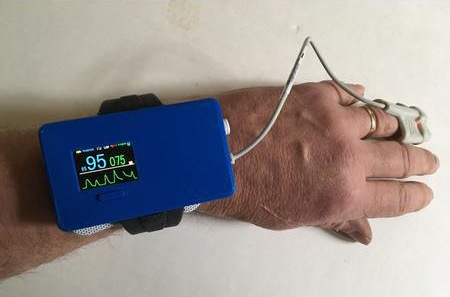
The U.S. Food and Drug Administration (FDA) has recently granted Breakthrough Device status to Med-botics, LLC’s Oxalert Enhanced Pulse Oximeter (EPOTM), a wearable device designed to prevent respiratory arrest and death from an opioid overdose. This is an FDA designation that aims to expedite the development, assessment, and review of medical devices that may be more effective than current options in treating/diagnosing life-threatening or irreversibly debilitating conditions.
What is Oxalert?
Oxalert marks a breakthrough in patient safety, offering an interactive monitor of oxygen levels that is worn on the wrist. The device contains a pulse oximeter and an arousal device that functions to restore conscious control of breathing to save the lives of overly sedated patients.
When Oxalert detects hypoxemia, or abnormally low concentrations of oxygen in the bloodstream, it verbally triggers the wearer to breathe. Common causes of hypoxemia include respiratory depression and sleep apnea. If the patient is deaf or too sedated to respond to verbal prompts, an arousing electrical stimulus is administered through electrodes that contact the wrist. This safe voltage is implemented to encourage breathing and wake the user up to better their chances of finding proper care.
A 2011 proof-of-concept study conducted at Oregon Health Science University (OHSU) found that a continuous pulse oximeter, nerve stimulator, laptop computer, and headphones (to model the device’s verbal prompting) automatically kept oxygen levels at or above 90% in heavily-sedated patients who had just undergone surgery.
Med-botics is a physician-owned start-up that licensed this patented technique from OHSU and redesigned the technology, which previously needed to be wheeled around on a cart. The result was the Oxalert EPO device that can be worn on the user’s wrist as a convenient, user-friendly device.
Clinical Implications
Currently, only about 10% of the 40 million in-patients receiving opioids after having surgery are continuously monitored. A study conducted in 2015 revealed hypoxemia is commonly undiagnosed in post-operative in-patients in the absence of continuous monitoring. This research also found that hypoxemia stabilizes upon arousal like that provided by the Oxalert device.
Of the 80,000 annual opioid overdose deaths, nearly all of them occur while the patient is at home. By giving the patient a convenient, wearable solution for overdose-induced hypoxemia, Oxalert could make opioids safer both in the hospital setting and at home.
“Providing early warning to over-sedated patients and their caregivers is important in the hospital and even more important at home,” said Dr. Richard Dutton, former Executive Director of the Anesthesia Quality Institute. “I believe this is a device that will save lives. I am looking forward to commercial availability of this product as an important step in the effort to eradicate ‘dead-in-bed’ adverse events, as well as the many other sequelae of opioid-induced post-operative hypoxemia.”
Oxalert EPO Wearable Device Granted FDA Breakthrough Status#oxalertepo #wearabledevice #FDA #pulseoximeter #medicaldevice #cn1699news
For more information, click link below. ? https://t.co/XTbfSHXwBW pic.twitter.com/ie1QZnwU4J
— CN1699 (@Cn1699) November 6, 2019







 © 2025 Mashup Media, LLC, a Formedics Property. All Rights Reserved.
© 2025 Mashup Media, LLC, a Formedics Property. All Rights Reserved.